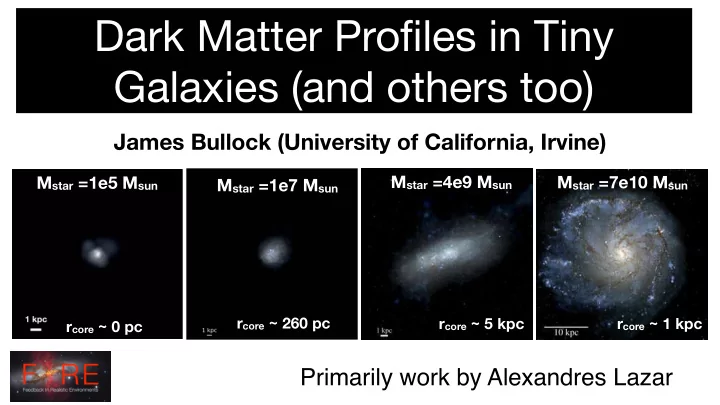

Dark Matter Profiles in Tiny Galaxies (and others too) James Bullock (University of California, Irvine) M star =4e9 M sun M star =7e10 M sun M star =1e5 M sun M star =1e7 M sun r core ~ 260 pc r core ~ 5 kpc r core ~ 1 kpc r core ~ 0 pc Primarily work by Alexandres Lazar
Outline One: Dark Matter density profiles in FIRE-2 simulations — A Universal “core-Einasto” profile from tiny dwarfs to the Milky Way. Two: A new mass estimator for transverse velocity dispersions in spheroidal galaxies — Implication for profile slopes in Sculptor & Draco
Cusp/Core Problem “SN feedback can JSB & Boylan-Kolchin, ARAA, 2017 explain this” Navarro, Eke & Frenk 1996 Flores & Primack 94; Moore 94
Cusp/Core Problem Core log slope density at (1-2%)Rvir Predict “sweet spot” for core formation is bright dwarfs: Cusp Di Cintio + 2014 see also Governato+12,Brooks & Zolotov 12, Read+16, etc.
Simulations See Hopkins+2018 53 galaxies simulated at high- resolution with FIRE2 physics. - Each resolved to 0.5% of the virial radius Lazar et al. 2019
Core 2014 Cusp Lazar et al. 2019 see also Governato+12,Brooks & Zolotov 12, Read+16, etc.
Lazar et al. 2019 Agreement with past 2014 work: “Sweet spot” for core formation is bright dwarfs: Smallest dwarfs remain cuspy Di ff erences: FIRE-2 simulations have more diversity / scatter in core properties Threshold for core formation is somewhat higher remain cuspy
A Universal Density Profile for Galaxy-Occupied Dark Matter Halos Einasto: Great for Dark Matter Only (Navarro 2004) 2 parameters, better than NFW Core Radius Core-Einasto: Great for our hydro runs 3 parameters, better than cNFW, Burkert, etc. Lazar et al. 2019
Core-Einasto: Excellent fit to DM in hydro simulations M star = 2.10 5 M sun M star = 5.10 6 M sun M star = 5.10 9 M sun M star = 8.10 10 M sun Lazar et al. 2019
Tiny Galaxies: Perfect place to test CDM M * = 1.e6 M sun CDM only CDM+feedback SIDM makes cores where CDM retains cusps. Problem: these tiny SIDM only SIDM+feedback galaxies are dispersion supported. Hard to extract density profiles. Robles+17
Density profiles notoriously hard to deconstruct from 1D velocity dispersions r Key degeneracy with R Anisotropy parameter σ los ( R )
A single radius where mass is accurately known from LOS velocities! Can show that if you fix LOS observables Wolf + 2010 Mass is independent of anisotropy at radius where log-slope of tracer profile is -3 See Walker+2009 for a related result
M -3 is mass estimator used in TBTF comparisons Boylan-Kolchin+2012
Velocity dispersion in the plane of the sky T R Massari + 2017; 2019
Tangential Velocity Dispersion r Can show Fix observables Mass is independent of anisotropy at radius where log-slope of tracer profile is -2 Lazar & JSB 2019
Tangential velocity dispersion from Massari+2019 Accurate mass from tangential velocity dispersion Lazar & JSB 2019
Draco & Sculptor both This work Wolf+2010 consistent with NFW halos 30 10 8 25 V circ ( r ) [km s − 1 ] M ( r ) [ M � ] 20 10 7 15 10 Draco Draco Draco Draco Sculptor Sculptor Sculptor Sculptor 10 6 5 10 − 1 10 0 0 . 2 0 . 4 0 . 6 0 . 8 1 . 0 r [kpc] r [kpc] Lazar & JSB 2019
Summary 1: FIRE-2 DM density profiles All profiles well fit by 3 parameter Lazar et al. 2019 “core-Einasto” 2014 Significant diversity in core sizes/ No core formation in tiny dwarfs M star < 10 6 M sun densities at scale of bright dwarfs
Summary 2: New Mass Estimator Wolf+2010 This work Accurate mass from tangential velocity dispersion 10 8 M ( r ) [ M � ] 10 7 Draco & Sculptor both consistent with NFW halos; more data required to Draco Draco provide tighter constraints Sculptor Sculptor 10 6 10 − 1 10 0 Lazar & JSB 2019 r [kpc]
Single-radius estimator good to <20% when compared to cosmological simulations González-Samaniego et al. 2017 Also Campbell et al. 2017
Recommend
More recommend